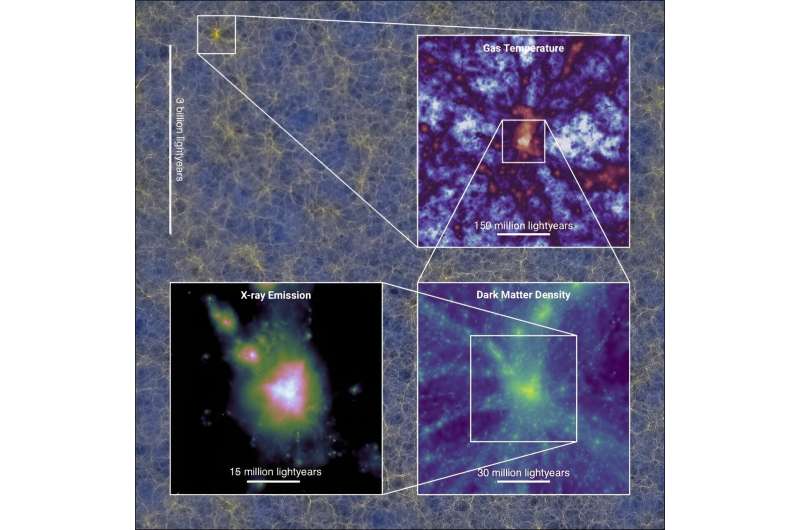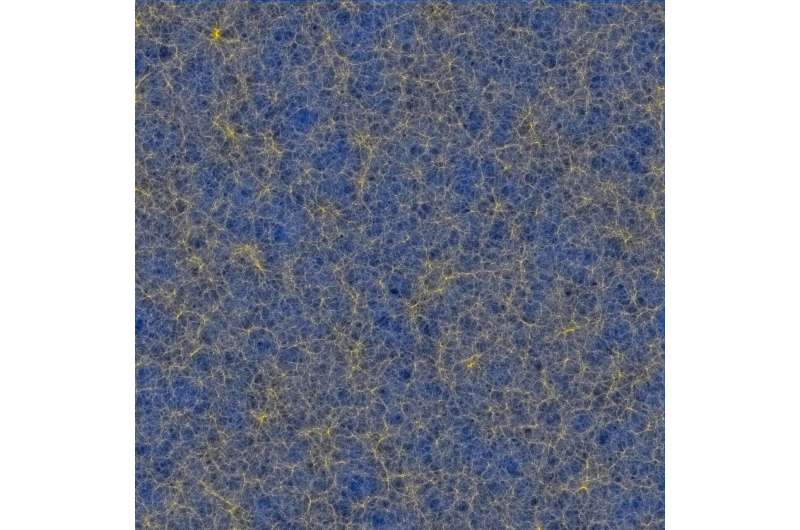This article has been reviewed according to Science X's editorial process and policies. Editors have highlighted the following attributes while ensuring the content's credibility:
fact-checked
peer-reviewed publication
trusted source
proofread
Astronomers carry out largest ever cosmological computer simulation

An international team of astronomers has carried out what is believed to be the largest ever cosmological computer simulation, tracking not only dark but also ordinary matter (such as planets, stars and galaxies), giving us a glimpse into how our universe may have evolved.
The FLAMINGO simulations calculate the evolution of all components of the universe—ordinary matter, dark matter, and dark energy—according to the laws of physics. As the simulation progresses, virtual galaxies and clusters of galaxies emerge. Three papers have been published in Monthly Notices of the Royal Astronomical Society: one describing the methods, another presenting the simulations and the third examining how well the simulations reproduce the large-scale structure of the universe.
Facilities such as the Euclid Space Telescope recently launched by the European Space Agency (ESA) and NASA's JWST collect impressive amounts of data on galaxies, quasars, and stars. Simulations such as FLAMINGO play a key role in the scientific interpretation of the data by connecting predictions from theories of our universe to the observed data.
According to the theory, the properties of our entire universe are set by a few numbers called 'cosmological parameters' (six of them in the simplest version of the theory). The values of these parameters can be measured very precisely in various ways.
One of these methods relies on the properties of the cosmic microwave background (CMB), a faint background glow left over from the early universe. However, these values do not match those measured by other techniques that rely on the way in which the gravitational force of galaxies bends light (lensing). These 'tensions' could signal the demise of the standard model of cosmology—the cold dark matter model.
The computer simulations may be able to reveal the cause of these tensions because they can inform scientists about possible biases (systematic errors) in the measurements. If none of these prove sufficient to explain away the tensions, the theory will be in real trouble.
So far, the computer simulations used to compare to the observations only track cold dark matter. "Although the dark matter dominates gravity, the contribution of ordinary matter can no longer be neglected," says research leader Joop Schaye (Leiden University), "since that contribution could be similar to the deviations between the models and the observations."
The first results show that both neutrinos and ordinary matter are essential for making accurate predictions, but do not eliminate the tensions between the different cosmological observations.

Simulations that also track ordinary, baryonic matter (also known as baryonic matter) are much more challenging and require much more computing power. This is because ordinary matter—which makes up only sixteen percent of all matter in the universe—feels not only gravity but also gas pressure, which can cause matter to be blown out of galaxies by active black holes and supernovae far into intergalactic space.
The strength of these intergalactic winds depends on explosions in the interstellar medium and is very difficult to predict. On top of this, the contribution of neutrinos, subatomic particles of very small but not precisely known mass, is also important but their motion has not been simulated so far.
The astronomers have completed a series of computer simulations tracking structure formation in dark matter, ordinary matter, and neutrinos. Ph.D. student Roi Kugel (Leiden University) explains, "The effect of galactic winds was calibrated using machine learning, by comparing the predictions of lots of different simulations of relatively small volumes with the observed masses of galaxies and the distribution of gas in clusters of galaxies."
The researchers simulated the model that best describes the calibration observations with a supercomputer in different cosmic volumes and at different resolutions. In addition, they varied the parameters of the model, including the strength of galactic winds, the mass of neutrinos, and the cosmological parameters in simulations of slightly smaller but still large volumes.
The largest simulation uses 300 billion resolution elements (particles with the mass of a small galaxy) in a cubic volume with edges of ten billion light years. This is believed to be the largest cosmological computer simulation with ordinary matter ever completed. Matthieu Schaller, of Leiden University, said, "To make this simulation possible, we developed a new code, SWIFT, which efficiently distributes the computational work over 30 thousand CPUs."
The FLAMINGO simulations open a new virtual window on the universe that will help make the most of cosmological observations. In addition, the large amount of (virtual) data creates opportunities to make new theoretical discoveries and to test new data analysis techniques, including machine learning.
Using machine learning, astronomers can then make predictions for random virtual universes. By comparing these with large-scale structure observations, they can measure the values of cosmological parameters. Moreover, they can measure the corresponding uncertainties by comparing with observations that constrain the effect of galactic winds.
More information: Joop Schaye et al, The FLAMINGO project: cosmological hydrodynamical simulations for large-scale structure and galaxy cluster surveys, Monthly Notices of the Royal Astronomical Society (2023). DOI: 10.1093/mnras/stad2419
Roi Kugel et al, FLAMINGO: Calibrating large cosmological hydrodynamical simulations with machine learning, Monthly Notices of the Royal Astronomical Society (2023). DOI: 10.1093/mnras/stad2540
Ian G McCarthy et al, The FLAMINGO project: revisiting the S8 tension and the role of baryonic physics, Monthly Notices of the Royal Astronomical Society (2023). DOI: 10.1093/mnras/stad3107
Journal information: Monthly Notices of the Royal Astronomical Society
Provided by Royal Astronomical Society




















